
East Grinstead High Level Station: Gallery 4: 1962  A rather immaculate BR Standard Class 4 4-6-0, with double chimney, has the 'right away' from Platform 5. It will be heading for either Victoria or London Bridge. Note the ground signal of the very familiar Southern Railway style; these could be found in abundance at East Grinstead. No. 75074 had been new in November 1955, the year before the BR device on the tender was introduced replacing the earlier 'cycling lion' version. She was to last in service until the end of Southern steam in July 1967, thereafter being sent to Salisbury for storage. From there she was sold for scrap to A. King & Son, Norwich where she was broken up in October 1967. Her service life of just over 11½ years was not untypical of the dismal story of the BR Standard steam types.
Photo Alan & Lynne Cullen 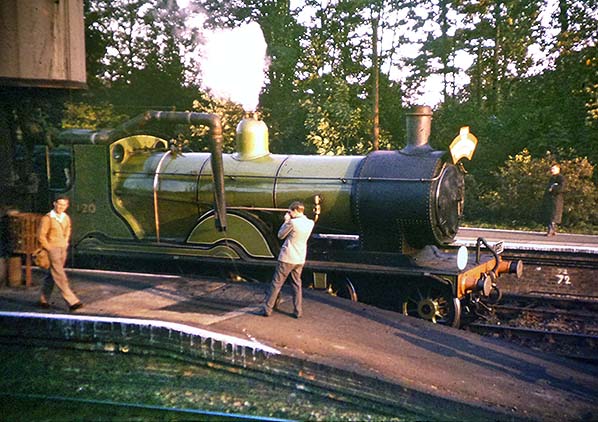
At 19:50 hrs on 24 June 1962 Class T9 4-4-0 BR No. 30120 waits at Platform 5. Two minutes later she will depart for London Bridge via Oxted and East Croydon. The occasion was the LCGB 'The Sussex Coast Limited' railtour which had set out from Waterloo and eventually reached East Grinstead from Eastbourne via Polegate and Heathfield (the so-called 'Cuckoo Line'). Between Eastbourne and Rotherfield & Mark Cross she double headed with Class M7 No. 30055, at which latter station the M7 was detached. No. 30120 is seen here restored to L&SWR livery as No. 120. Her history under British Railways followed an 'is she is she not withdrawn' pattern. Withdrawn, at least in theory, from Exmouth Junction shed on 18 March 1961 she was claimed for preservation by the National Railway Museum, moved to Eastleigh and given an overhaul including the repaint into L&SWR livery. This done she continued in service, working both railtours and ordinary service trains which meant, therefore, she was still in capital stock. Withdrawal from capital stock came in July 1963 but even then she continued to operate railtours until October of that year. She was the final member of the T9 Class to remain in service and is the sole example to survive in preservation.
Photo by Alan & Lynne Cullen 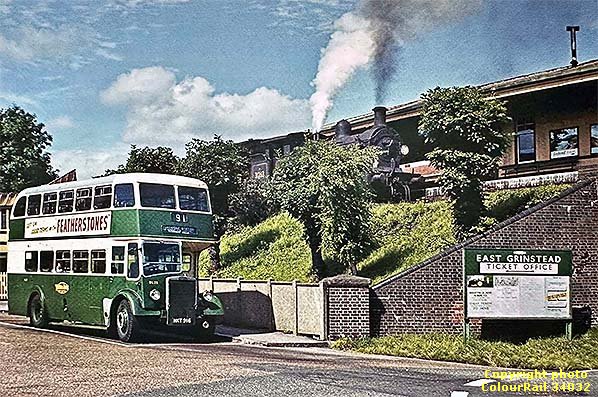
On an apparently pleasant day 19.8.1962 ex-SE&CR H Class 0-4-4T No. 31263 sits in the High Level station doing her best to annoy the photographer with her blowing-off safety valves. She has arrived with a train from Three Bridges. Withdrawn from Three Bridges on 5 January 1964, No. 31263 was purchased for preservation, initially in the hope of operating on the Westerham branch but this preservation scheme failed. She was then stored at various locations until arriving at the Bluebell Railway which of course means she can still be seen at East Grinstead today, albeit at the Bluebell Railway's platform near the former Low Level station, now known simply as 'East Grinstead'. Star of the show, with no offence to railway enthusiasts, is Leyland Titan PD2/12 fleet number DL23 of the Maidstone & District Motor Services. New in August 1951 she had a Leyland 55-seat Lowbridge body. Lowbridge bodies had a sunken side gangway in the upper deck and, usually, four aside bench seats. Lowbridge vehicles were jolly good fun for youngsters but to everybody else, not least conductors, they were an utter nuisance. Passengers sitting in the offside lower deck seats frequently banged their heads on the sunken gangway about their seats. No. DL23 is thought to have been withdrawn in 1965 but in 1962 was operating on service 91 to Tonbridge. The rather useless destination display, being very difficult to read from a distance, was typical of Maidstone & District vehicles. Up on the station is a British Railways advertisement for Ireland while at ground level the advertisement on the left promotes cheap tickets to Hove for the Brighton & Hove Albion F.C. By 1962, of course, it was necessary to travel via Three Bridges to reach Brighton or Hove.
Copyright photo from ColourRail
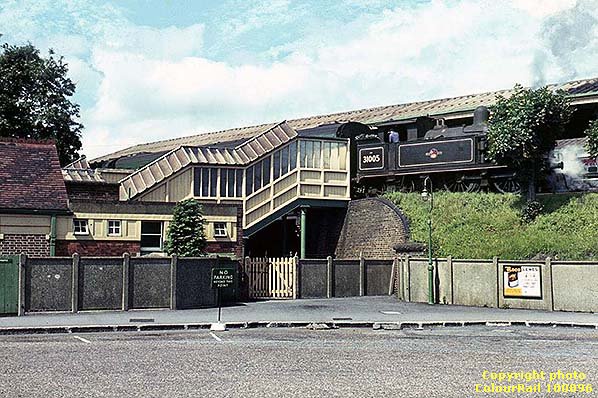
On 19 August 1962 reasonably clean H Class No. 31005 is caught by the camera with a Maunsell Push-Pull set. Modellers may appreciate this view for the detail of the Low Level station footbridge staircase. Also on view is some of the Southern's quite ghastly concrete walling. This was cast in sections at the Exmouth Junction Concrete Works and assembled as required on site. The advertisement board on the right advertises, on its left, 'Gloco', a form of refined coke sold as smokeless fuel and introduced sometime around 1959 - 1960. On the board's right is an advertisement for Lewes but other details are unreadable. Possibly it was advertising Lewes Racecourse, which dated from the 18th Century but closed down in 1964. Whatever the attraction was at Lewes in 1962, by that time it was no longer possible to travel by train directly from East Grinstead.
Copyright photo from ColourRail 
On 19 August 1962 Class H No. 31263 approaches from Three Bridges as the West 'box signalman waits to take the train staff from the footplate crew. As the signals in the background indicate, the route is set for the train to enter Platform 3 on the left. The line branching off to the right leads to St Margaret's Junction and the Oxted line. As the signalling and pointwork shows, there was a fair degree of operational flexibility. This station was always known as 'East Grinstead High Level' yet it will be noted the running-in boards, and for that matter the Southern 'target' signs, one of which can be seen to the right, did not display the 'High Level' suffix. The Low Level station name was also not given the relevant suffix. The reason, despite the 'High' and 'Low' designations, was it was for all intents and purposes a single station with high and low level platforms. 'Low Level' comprised Platforms 1 and 2 while 'High Level' comprised Platforms 3 to 6, the latter being from left to right in this view.
Copyright photo from ColourRail 
An elevated view across the forecourt from the High Level Platform 3 on 20th August 1962. Two of the motor cars, the Morris Oxford Series V (parked outside the station building) and the Ford Anglia 105E (parked behind the Standard 10 with PLL registration) were first introduced in 1959. Of the other vehicles present which can be identified are a Jaguar Mk VIII, a couple of Hillman Minx models, a Ford 100E, a Morris Oxford Series III, a Rover P4. Parked outside the station entrance is an Austin A30 van signwritten 'Courier'. This was probably the East Grinstead Courier newspaper. To its right is what looks like, going by the position of its badge, a Riley One-Point-Five. At far right is what appears to be an Austin 7 convertible. Among the unidentified vehicles are a number of older models from the 1940s. Car ownership at the time was very much an indication of status and what we see here is range of what we might call 'economy' vehicles such as the Standard, the Ford 100E and the suspected Austin 7 to the more upmarket Jaguar and Rover plus, at a pinch, the Riley. Some of these vehicles likely belonged to London commuters. In the background, left of centre, is the closed line to Horsted Keynes and Culver Junction crossing Imberhorne Viaduct. This line, apart from the Horsted Keynes - Sheffield Park section, was not lifted until 1963 but the section over the viaduct was retained for many more years to stable rolling stock. Beyond the viaduct is the cutting which was used for landfill before, many years later, being excavated for the Bluebell Railway. The line south to the viaduct was also still used, at the time of the photograph, for access to the dock at which a van is stabled. The connection to the goods yard, largely hidden from view, appears to be somewhat overgrown and out of use.
Photo by Ian D Noble from his Flickr photostream 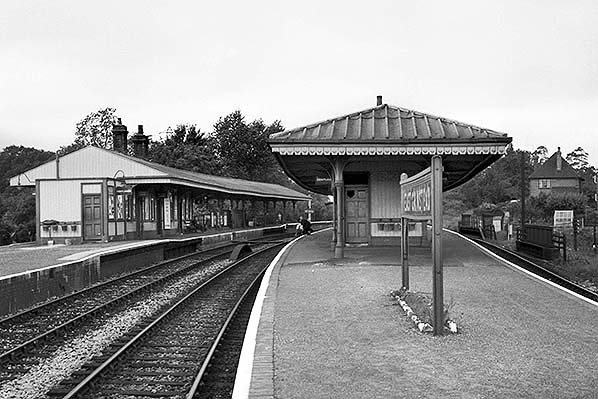 East Grinstead station looking west from platform 5 on 20 August 1962. The platforms are deserted apart for two people on the staff crossing - they are assumed to be railway personnel.
Photo by Ian D Noble from his Flickr photostream 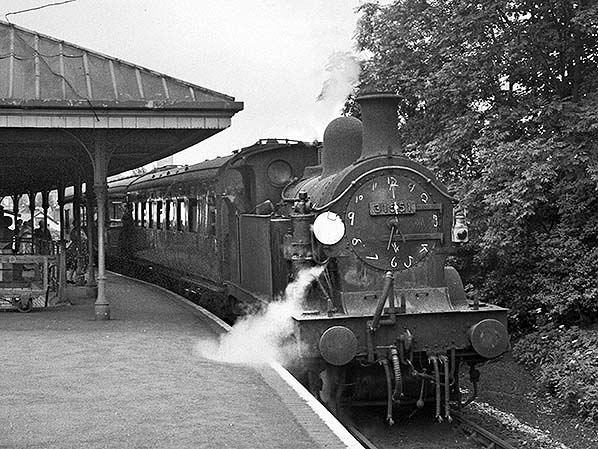
On 20 August 1962 Class H No. 31551 has arrived from Three Bridges with a Maunsell Push-Pull set. It will presumably continue to Tunbridge Wells West. The clock face on the locomotive's smokebox door must have been useful for letting people know the time as it scooted along the line. However, whether the time really was 16:32hrs as indicated by the 'darts' is another matter. What we can be sure of, though, is the 'darts' telling the correct time twice per day.
Photo by Ian D Noble from his Flickr photostream 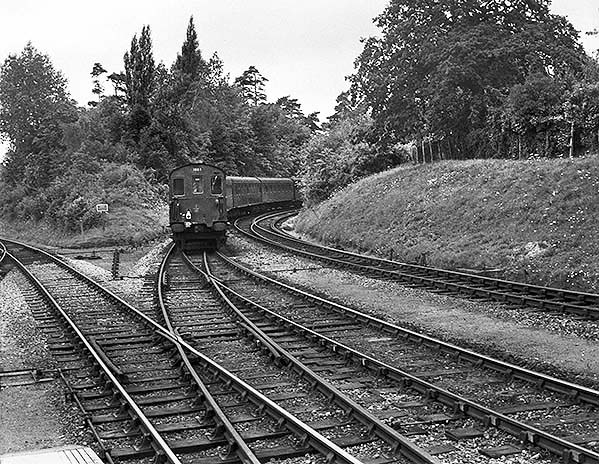
On 20 August 1962 Class 6S, later Class 201, 'Hastings' DEMU No. 1003 has just departed from Platform 5 and turns northwards towards Oxted. The photographer was standing on Platform 4 and as mentioned elsewhere the connection from this platform to the St Margaret's Curve was little used following the signalling alterations of 1958. In this view the condition of the rail heads makes this quite obvious. It seems, therefore, that Platforms 3 and 4 were the preserve of the local Tunbridge Wells - Three Bridges trains with Platforms 5 and 6 being for Oxted and London trains. DEMU No. 1003 was one the units built with narrow bodies due to restricted clearances on the then-non-electrified Hastings line but, as this photograph shows, they were by no means confined to the Charing Cross - Hastings line. No. 1003 was taken out of service in December 1964 as part of a plan to create the 3-car 'Tadpole' units which became Class 206. The story of these disbandments and reformations is far too complex to tell in an image caption but plenty of comprehensive information is available on line.
Photo by Ian D Noble from his Flickr photostream 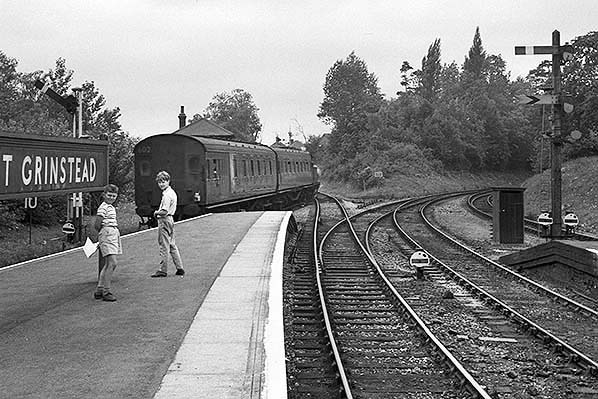 On 20 August 1962 Class H No. 31551 departs towards Three Bridges with Maunsell Push-Pull set No. 602 and will call at Grange Road and Rowfant along the way. Compared with the photograph of the Fairburn 2-6-4T a bracket signal is now in position just beyond what by now had become 'A' signal box. Strangely, perhaps, the rather ancient lower-quadrant signals on the right were never replaced although it does appear they had been moved a little further from the water tower just out of view to the right. The rails branching off onto St Margaret's Curve directly ahead of the camera do not seem to be seeing much use by this time and the points are controlled by the adjacent ground signal, one of several to the unmistakable Southern Railway style on view in this scene. One wonders if the two boys were the photographer's sons.
Photo by Ian D Noble from his Flickr photostream
 Believed to have been taken in October 1962 this photograph shows Dr. Richard Beeching ascending the stairs from the subway to Platform 5. Impressions are that he was going on holiday but he was more likely heading for his office London. Dr. Beeching had moved to East Grinstead in 1958; he died in hospital in 1985 but otherwise spent the rest of his life at his home on the Lewes Road at Brockhurst, on the south-eastern edge of East Grinstead. Having been involved with the so-called 'Stedeford Committee' in 1959/60 he became, in March 1961, a part-time member of the British Transport Commission and from 1 January 1963 first Chairman of the British Railways Board. He was seconded from ICI (Imperial Chemical Industries) where he was Technical Director. He returned to ICI In June 1965. The Way Out, as indicated by the suspended sign, was via the subway to the Down Low Level platform. The advertisement atop what appears to be a timetable board is of interest. Hampton & Sons, purveyors of furniture to the upper class and the ocean liners RMS Queen Mary and RMS Queen Elizabeth, had been taken over in 1903 by Waring & Gillow but the Hampton name remained in use.
Photo by Arthur Jones 
In 1962 a Maunsell N Class 2-6-0 was caught apparently stationary at Platform 5 with a short goods train. These locomotives had a couple of nicknames; 'Mongolipers' and 'Woolworths'. The origin of the first is unclear but the second originated from batch being assembled from kits of parts at Woolwich Arsenal. The locomotive in the photograph would appear to be No. 31823 but the final two digits are by no means clear.
Photo from John Mann collection Click here for East Grinstead High Level: Gallery 5
1962 - 1964
 Home
Page Home
Page
|

 On 28 August 1962 the camera caught brand new DEMU No. 1302 which had just arrived from the Oxted direction. Originally classified as '3D East Sussex', later Class 207, these units were a restyled version of the earlier Class 2H and 3H 'Hampshire' units, later Class 205. Like many of these units No. 1302 went through various changes which included a period as a 2-car unit before becoming a 3-car again with the addition of an ex 4CEP EMU centre trailer. However, No. 1302 retained its original Driving Motor and Driving Trailer vehicles for its entire life which lasted until August 2004, by which time she was numbered 207203. She was to enter preservation, in 2-car form, but was to become the victim of an arson attack on 20 May 2016 which destroyed Driving Trailer No. S60901, the vehicle nearest the camera in this view.
On 28 August 1962 the camera caught brand new DEMU No. 1302 which had just arrived from the Oxted direction. Originally classified as '3D East Sussex', later Class 207, these units were a restyled version of the earlier Class 2H and 3H 'Hampshire' units, later Class 205. Like many of these units No. 1302 went through various changes which included a period as a 2-car unit before becoming a 3-car again with the addition of an ex 4CEP EMU centre trailer. However, No. 1302 retained its original Driving Motor and Driving Trailer vehicles for its entire life which lasted until August 2004, by which time she was numbered 207203. She was to enter preservation, in 2-car form, but was to become the victim of an arson attack on 20 May 2016 which destroyed Driving Trailer No. S60901, the vehicle nearest the camera in this view.